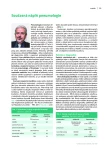Diagnostics and treatment of community-acquired pneumonia – simplicity is the key to success
Authors:
Vítězslav Kolek; Petr Jakubec; Stanislav Losse
Authors‘ workplace:
Klinika plicních nemocí a tuberkulózy LF UP a FN Olomouc
Published in:
Vnitř Lék 2017; 63(11): 770-775
Category:
Reviews
Overview
Pneumonia is the most wide-spread infectious disease and requires unrelenting attention. It is defined as an acute inflammatory disease affecting pulmonary alveoli, respiratory bronchioles and the pulmonary interstitium. In recent years we have seen the endeavour to rationalize the approach to pneumonias and utilize the current methods of administering effective antibiotics to reduce occurrence of complications, limit the number of hospitalizations and shorten the length of treatment. With the awareness of all the potential agents it is empiric therapy which predominates, being supported by the knowledge of a regional epidemiological situation, good diagnosing and experience of rational antibiotic treatment. Very important is categorization of patients based on possible risks of complications and mortality. Considering that an appropriate form of treatment is chosen: outpatient care or hospitalization.
Key words:
community-acquired pneumonia – treatment criteria – prognosis – occurrence
Sources
1. Kolek V, Kolář M, Kašák V et al. Diagnostika a léčba komunitně získané pneumonie dospělých. Vnitř Lék 2011; 57(10): 858–866.
2. Niederman MS, McCombs JS, Unger AN et al. The cost of treating community-acquired pneumonia. Clin Ther 1998; 20(4): 820–837.
3. Guest JF, Morris A. Community-acquired pneumonia: the annual cost to the National Health Service in the United Kingdom. Eur Respir J 1997; 10(7): 1530–1534.
4. Gibson GJ, Loddenkemper R, Lundbäck B et al. Respiratory health and disease in Europe: the new European Lung White Book. Eur Respir J 2013; 42: 559–563. Dostupné z DOI: <http://dx.doi.org/10.1183/09031936.00105513>.
5. File TM. Community-acquired pneumonia. Lancet 2003; 362(9400): 1991–2001.
6. Barlow GD, Lamping DL, Davey PG et al. Evaluation of outcomes in community-acquired pneumonia: a guide for patients, physicians, and policy-makers. Lancet Infect Dis 2003; 3(8): 476–488.
7. Woodhead M, Blasi F, Ewig S et al. Guidelines for the management of adult lower respiratory tract infections--full version. Clin Microbiol Infect 2011; 17(Suppl 6): E1-E59. Dostupné z DOI: <http://dx.doi.org/10.1111/j.1469–0691.2011.03672.x>.
8. Mandell LA, Wunderink RG, Anzueto A et al. Infectious Diseases Society of America/American Thoracic Society consensus guidelines on the management of community-acquired pneumonia in adults. Clin Infect Dis 2007; 44(Suppl 2): S27-S72.
9. Macfarlane JT, Boldy D. 2004 update of BTS pneumonia guidelines: What´s new? Thorax 2004; 59(5): 364–366.
10. Dean NC, Silver MP, Bateman KA et al. Decreased mortality after implementation of a treatment guideline for community-acquired pneumonia. Am J Med 2001; 110(6): 451–457.
11. Kolek V, Fojtů H, Grygárková I et al. Pneumonie vyžadující hospitalizaci: výsledky dvouleté multicentrické studie v České republice. Int Med Prax 2002; 4(7): 347–352.
12. Pletz MW, Ewig S, Lange C et al. Update Pneumonie 2012. Dtsch Med Wochenschr 2012; 137(44): 2265–2284. Dostupné z DOI: <http://dx.doi.org/10.1055/s-0032–1305297>.
13. de Roux A, Ewig S, García E et al. Mixed community-acquired pneumonia in hospitalised patients. Eur Respir J 2006; 27(4): 795–800.
14. Gleason PP, Meehan TP, Fine JM et al. Associations between initial antimicrobial therapy and medical outcomes for hospitalized elderly patients with pneumonia. Arch Intern Med 1999; 159(21): 2562–2572.
15. Smith SB, Ruhnke GW, Weiss CH et al. Trends in Pathogens Among Patients Hospitalized for Pneumonia From 1993 to 2011. JAMA Intern Med 2014; 174(11): 1837–1839. Dostupné z DOI: <http://dx.doi.org/10.1001/jamainternmed.2014.4344>.
16. McKinnell J, Class P, Blumberg P et al. Clinical Predictors of Antibiotic Failure in Adult Outpatients with Community-Acquired Pneumonia. Am J Respir Crit Care Med 2017; 195: A2644. Dostupné z WWW: <http://www.atsjournals.org/doi/abs/10.1164/ajrccm-conference.2017.195.1_MeetingAbstracts.A2644>.
17. Kolek V, Bartoš V, Fojtů H et al. Studie PAP – Pneumonie v ambulantní péči. Stud Pneumol Phthiseol 2007; 67(4): 146–154.
18. Moberley S, Holden J, Tatham DP et al. Vaccines for preventing pneumococcal infection in adults. Cochrane Database Syst Rev 2013; (1): CD000422.Dostupné z DOI: <http://dx.doi.org/10.1002/14651858.CD000422.pub3>.
19. Kolek V, Vágnerová I et al. Kapesní původce ambulantní léčbou respiračních infekcí. Maxdorf: Praha 2016. ISBN 978–80–7345–490–6.
20. Ho PL, Tse WS, Tsang KWT et al. Risk factors for acquisition of Levofloxacin-resistant Streptococcus pneumoniae: A case-control study. Clin Infect Dis 2001; 32(5): 701–707.
21. Waterer GW, Somes GW, Wunderrink RG. Monotherapy may be suboptimal for severe bacteraemic pneumococcal pneumonia. Arch Intern Med 2001; 161(15): 1837–1842.
22. Martinez JA, Horcajada JP, Almela M et al. Addition of a macrolide to a beta-lactam-based empirical antibiotic regimen is associated with lower in-hospital mortality for patients with bacteremic pneumococcal pneumonia. Clin Infect Dis 2003; 36(4): 389–395.
23. Soo Hoo GW, Wen YE, Nguyen TV et al. Impact of clinical guidelines in the management of severe hospital-acquired pneumonia. Chest 2005; 128(4): 2778–2787.
24. Eccles S, Pincus C, Higgins B et al. Pneumonia. Diagnosis and management of community and hospital-acquired pneumonia in adults. BMJ 2014; 349:g6722. Dostupné z DOI: <http://dx.doi.org/10.1136/bmj.g6722>.
25. Ito A, Ishida T, Tokumasu H et al. Prognostic Factors in Hospitalized Community-Acquired Pneumonia. A Retrospective Study of a Prospective Observational Cohort. BMC Pulm Med 2017; 17(1): 78. Dostupné z DOI: <http://dx.doi.org/10.1186/s12890–017–0424–4>.
Labels
Diabetology Endocrinology Internal medicineArticle was published in
Internal Medicine

2017 Issue 11
Most read in this issue
- Spirometry – basic examination of the lung function
- Non-invasive ventilation
- Small-cell lung cancer: epidemiology, diagnostics and therapy
- Pneumonia in immunocompromised persons
